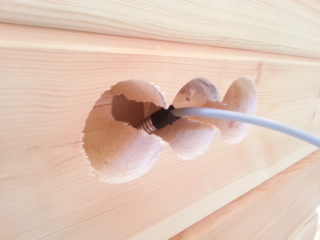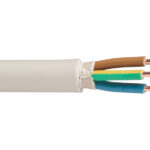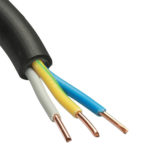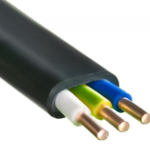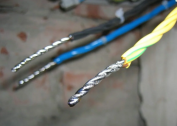Hidden wiring in a wooden house is laid inside walls, floors or floors. It does not affect the design of the room, minimizes the contact of residents with electricity. Structures made of logs or timber provide a favorable microclimate. They have a lot of air, the temperature is excellent. The main drawback of wooden buildings is the fire hazard. The use of flammable material places high demands on the quality of electrical installation. The wiring device must be performed strictly according to the requirements of the PUE and GOST.
Compliance - Safety Guaranteed
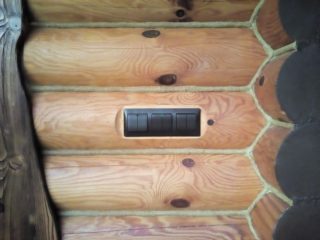
Dry wood, especially coniferous, ignites from any sparking wire. Errors or an unfair attitude to work during the installation of wiring can turn into a tragedy. It is better to entrust the development of the project and the installation of electricians to people with relevant knowledge and experience.
Installation work is carried out in accordance with the "Rules for the Installation of Electrical Installations", SNiPam, GOST R 50572.1-93 standards. Provisions of documents help ensure the safety of people, property and pets. By observing their requirements, fires and electric shocks can be prevented.
Advantages and disadvantages of hidden wiring
For wooden buildings, an open type of wiring is recommended. This option allows you to monitor its condition, repair it in a timely manner. But the cables on the walls do not always fit into the interior. Hidden wiring has several advantages:
- The wiring does not interfere with the decoration of the walls and ceiling.
- Sockets and switches are buried in the enclosing structures.
- The wires hidden in the channel are less likely to suffer mechanical damage.
- Wires do not become a place of settling of dust and cobwebs.
The aesthetic component is a decisive factor when choosing the method of laying electrical communications.
The disadvantages of the hidden option make wiring an object of increased threat:
- The possibility of damage to the wires, which cannot be detected in time.
- Difficulties with connecting additional points.
- The likelihood of cable damage due to loss of communications.
The large volume and high cost of work on arranging electrics is also a minus.
Special Security Requirements
There are strict regulatory requirements for installing electricians in a wooden house. All communications must be hidden in structures made of non-combustible materials. No contact with the tree. You can not use protective boxes and channels made of plastic, metal hoses. What conditions must be observed:
- Wires are hidden in metal pipes. The best option is copper, it bends easily. The installer will have a laborious process of pulling cables along the entire length of the pipes. For its implementation, a conductor is laid in advance.
- When drawing up the wiring diagram, it is recommended to minimize the number of turns.
- Circuit breakers and RCDs are installed in the shield.
During a short circuit of hidden wiring, an electric arc forms in a wooden log house. From high temperature, wood ignites. A layer of metal, plaster or other non-combustible material will prevent an emergency. A plastic pipe (corrugation) will not be able to localize a fire. She herself will begin to melt.
PVC sheath is vulnerable to rodents, which can gnaw it and damage the insulation of communications. An expensive and time-consuming way to lay wires in metal pipes is the safest.
One of the conditions for preventing fires is the purchase of quality materials. Automatic machines, RCDs, wires should be from manufacturers with a good reputation.
Features of laying hidden wiring in a wooden house
Concealed cabling is a time-consuming process. Drilling of vertical channels during logging will be required. Horizontal gating is carried out after the construction of walls. Arrangement of electricians often occurs after interior decoration. In this case, the wires are pulled between the gypsum board lining and the wall. They are also housed in metal structures. This material is capable of localizing fire. Installation features include:
- The wire should occupy up to 40% of the diameter of the pipe in which it is laid.
- The sections of the transition of communications between the walls and the wiring places are insulated with metal sleeves or alabaster plaster.
- Pipes in which the route passes are connected to ground.
- The connection of the individual sections must be tight. Protective sleeves are put on sharp edges so as not to damage the insulation.
Drilling channels in a tree requires a lot of time and the use of special tools. Cables enclosed in a metal hose can be protected on all sides with a layer of plaster. This method is rarely used for log walls. One of the features of a wooden house is shrinkage. This factor is taken into account when laying an electric highway.
Wire selection
The wiring in the log house should be punctured by copper wires. Two types of products are recommended:
- VVGNG with indices A and LS is a power cable, each core of which has an insulation of its own color. The shell is made of a material that does not support combustion.
- NYM - A cable with round copper conductors is produced according to German standard. The insulation and shell are self-extinguishing.
- NYM
- VVGng (LS)
- VVGng (A)
When preparing the project, the load on the cable is calculated. Based on the calculations, the wire cross section is selected. It must have 3 or 5 cores.
The lines of laying the wires are outlined according to the rules of the PUE. In areas where complex wiring is required, junction boxes are installed. It is forbidden to cover them with decorative details. When deepening pipes for the route, they act reasonably; excessive hollowing of a tree will lead to a deterioration in the strength of the structure.
Installation Rules
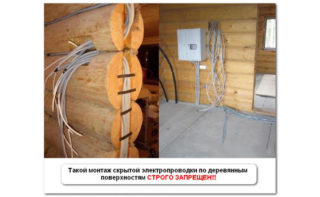 Hidden wiring in a wooden house is laid in accordance with a scheme approved by specialists. At installation it is considered:
Hidden wiring in a wooden house is laid in accordance with a scheme approved by specialists. At installation it is considered:
- The choice of diameter and wall thickness of the pipe depends on the characteristics of the cable. A wire with a minimum cross section is not standardized - aluminum 4 mm2, copper - 2.5 mm2.
- Separate parts of the channel are connected by thread or welding, copper pipes are expanded.
- Protective boxes and structures are fastened with clamps.
- In order not to violate the integrity of the enclosing structures, it is recommended that the route be laid in the recesses of the door and window openings, behind the skirting boards.
- Pipes are laid at an angle that allows condensate to drain.
To prevent damage to the protective channels by corrosion, galvanized or stainless materials are used. After broaching, the insulation resistance of the wires is checked.
Overlap Posting
Laying the route along the overlap is a way to avoid the effort of logging the logs. Wires are laid in pipes, but are located on beams. The holes are cut out only for cables going down to sockets and switches. An alternative to pipes is the use of trays - copper or galvanized. They reliably isolate electrical wiring from wood. Trays require connection to a ground loop.
Location of sockets and switches
Under all sockets and switches metal boxes are installed. When installing a continuous circuit, grounding of the switchboard is allowed. In other cases, the boxes are grounded with the pipe. For reliable connection of elements, welding is used.
Grounding and installation of RCD
Installation of the grounding system and residual current devices (RCD) is necessary in a building with increased fire hazard. In private homes, two types of grounding are common: TT and TN-C-S. Be sure to install differential machines in the switchboard that protect against short circuit, and RCDs that respond to current leakage.
The main options for the ground loop:
- Triangular - consists of three pins-electrodes connected by steel strips. Rods up to 2.5 m long are driven into the ground in the form of an isosceles triangle. Welding is used to connect parts.
- Linear - the best option for a lack of free space. The pins and connecting strips are placed in one line.
- Modular pin - this method requires the purchase of a special grounding device from mounting pins and couplings. The length of one part is 1.5 m, for efficient operation it is required to connect elements up to 10-40 m. The kit has a clip for the wire going to the shield.
The fabricated circuit is connected to the PE ground bus. The resistance of the materials used to create it should not exceed 4 ohms.
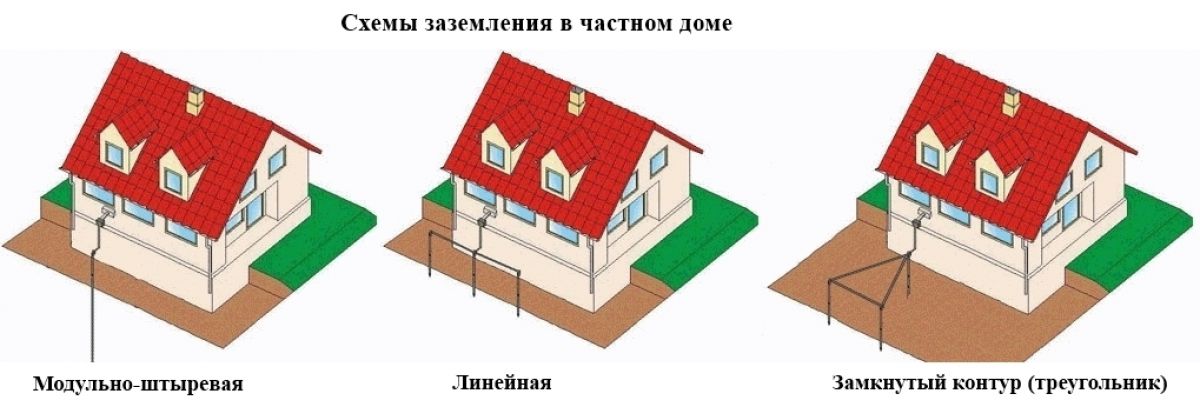
Wiring Test
After completion of installation work, a representative of the electrical laboratory is called. He will take measurements on the following indicators:
- grounding resistance;
- RCD
- insulation resistance;
- loop measurement phase zero.
After testing, a conclusion is given on the condition of the wiring and the possibility of its operation. Provided that the electrical installation is correctly performed, hidden wiring will not become a source of fire or other problems.

